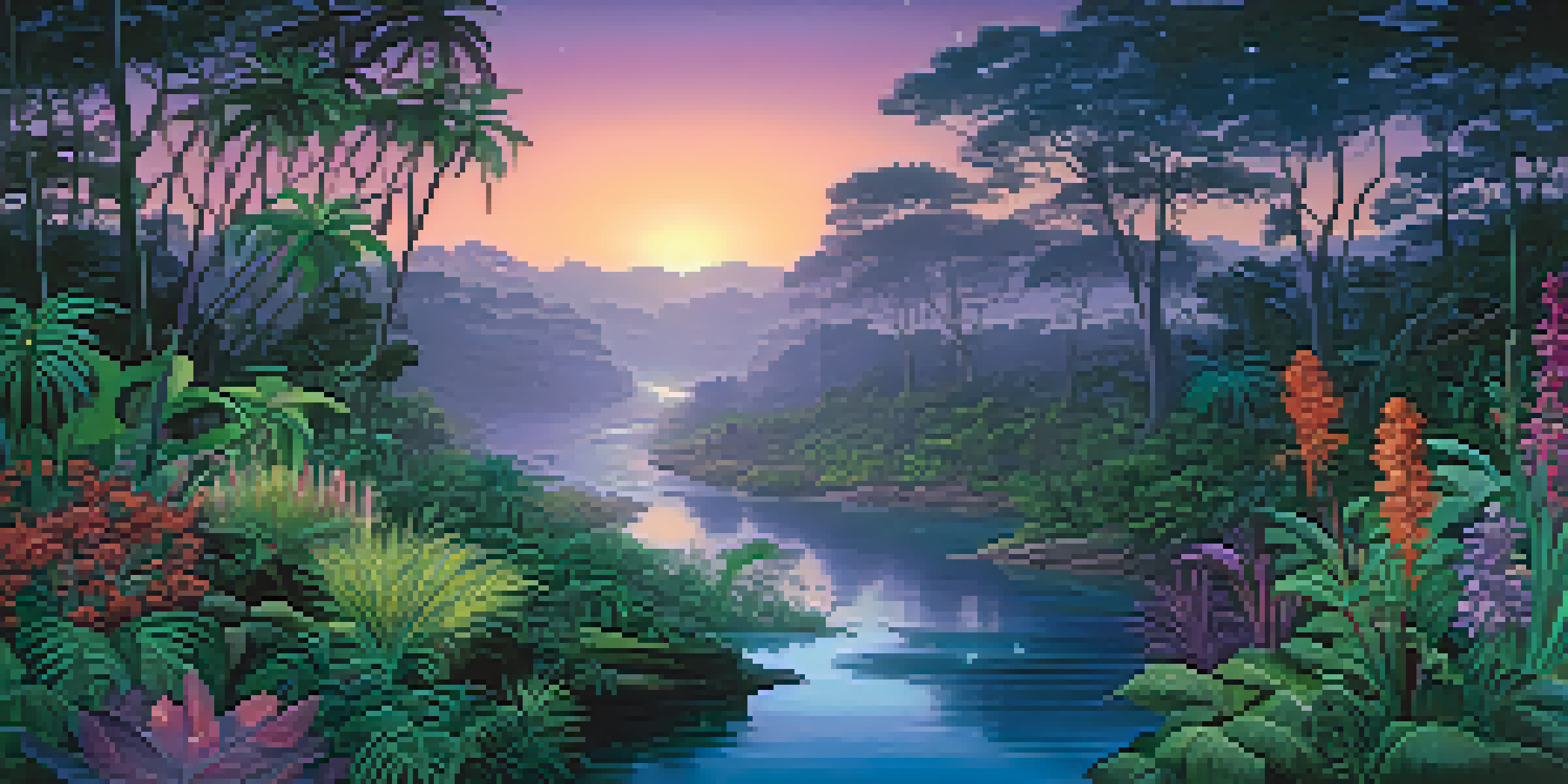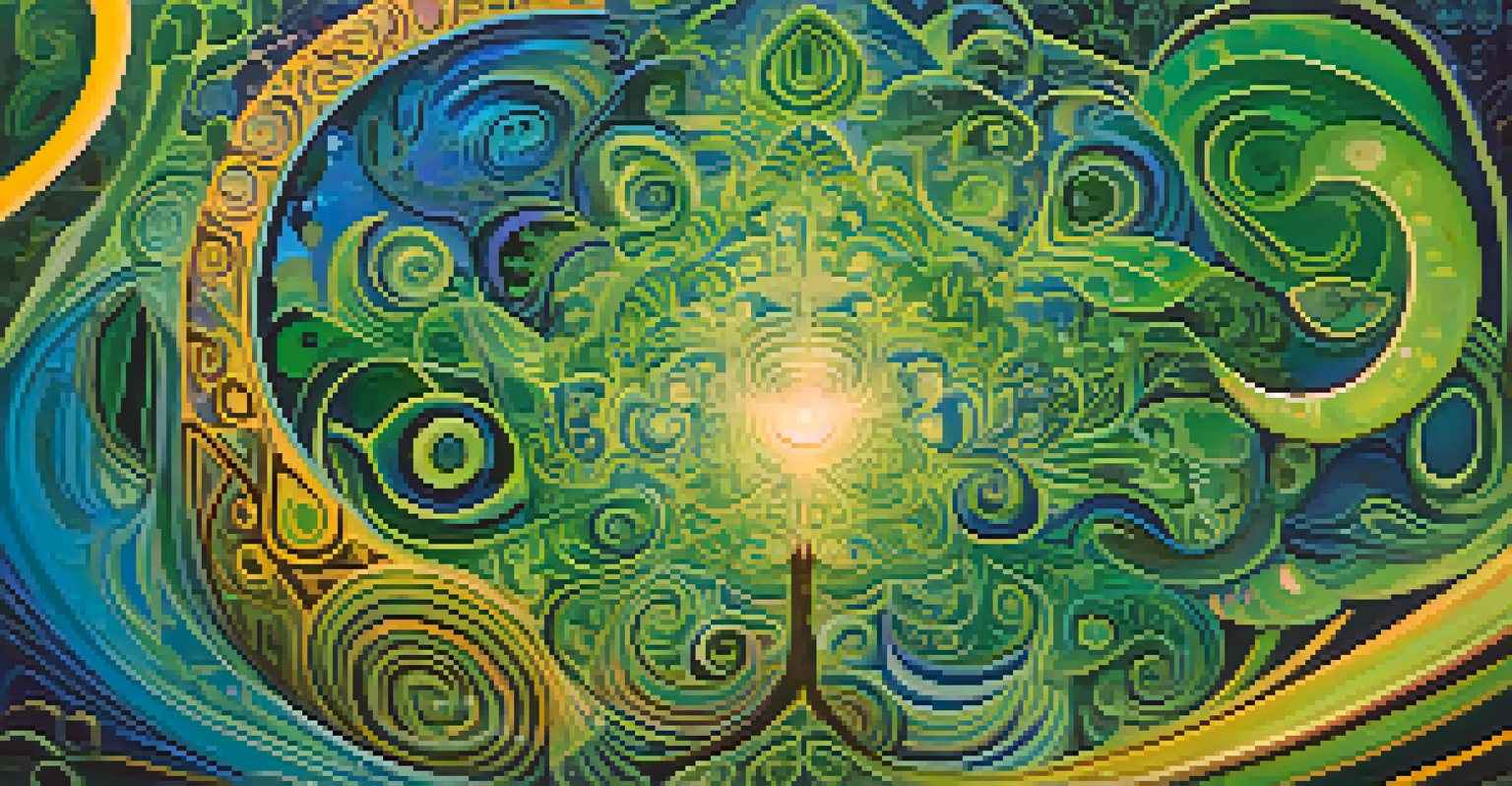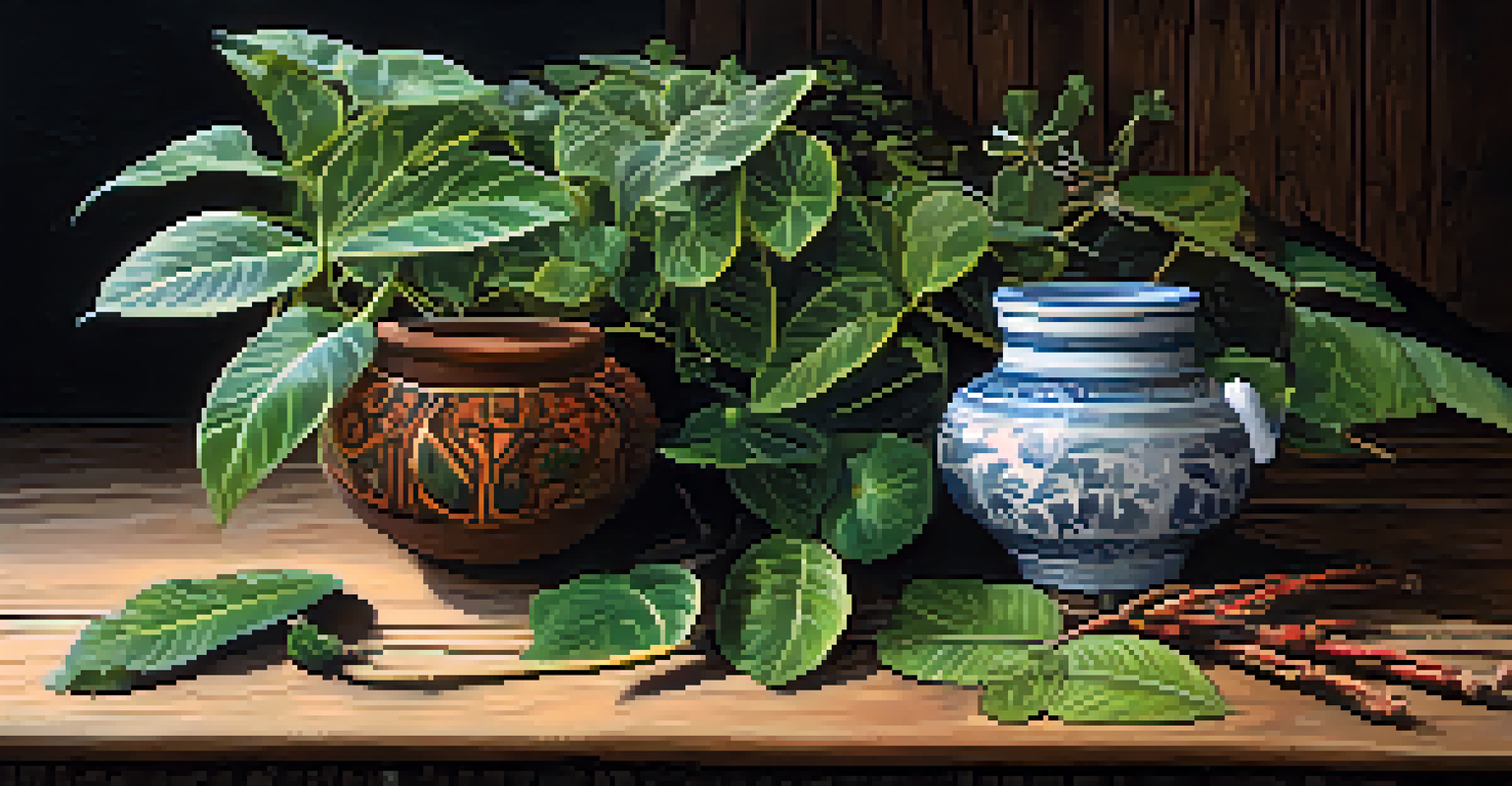Ayahuasca in Graphic Novels: Visions and Representations

Understanding Ayahuasca: A Cultural and Spiritual Context
Ayahuasca is a powerful plant medicine traditionally used by Indigenous Amazonian cultures. It is often consumed in a ceremonial context, leading to profound spiritual experiences and visions. The brew, made from the Banisteriopsis caapi vine and other plants, is known for its psychoactive properties, which can evoke deep introspection and connection to nature. This cultural significance provides a rich backdrop for storytelling in graphic novels.
The experience of Ayahuasca is a profound journey that often leads to self-discovery and healing.
In graphic novels, the representation of Ayahuasca often transcends mere visuals, delving into its spiritual and healing aspects. Creators can explore themes of personal transformation and communal rituals, making the mystical experience accessible to readers. Understanding the cultural roots of Ayahuasca helps to frame these narratives and enriches the reader’s experience, bridging the gap between ancient traditions and contemporary storytelling.
Moreover, through the lens of graphic novels, readers can visualize the often elusive experiences of Ayahuasca journeys. The combination of art and narrative allows for a multi-sensory exploration of what these journeys entail, from vivid imagery to emotional resonance. This unique format invites readers to engage with the subject matter on a deeper level, sparking curiosity about both the lore and the modern practices surrounding this sacred plant.
Graphic Novels as a Medium for Ayahuasca Experiences
Graphic novels serve as an innovative medium to convey complex themes, such as the experience of Ayahuasca. The visual elements enhance storytelling, allowing artists to depict the surreal and often abstract sensations that come with the Ayahuasca experience. Colors, shapes, and styles can reflect the emotional depth and transformative power of the journey, creating a tapestry of visuals that resonates with readers.

For instance, a graphic novel might illustrate a character’s inner turmoil through chaotic, swirling designs, symbolizing their mental state before taking Ayahuasca. As the character undergoes their journey, the art can evolve, showcasing clarity, serenity, or even overwhelming beauty. This dynamic representation allows readers to feel the shifts in perspective and understanding that often accompany Ayahuasca experiences.
Ayahuasca's Cultural Significance
Ayahuasca serves as a powerful plant medicine deeply rooted in Indigenous Amazonian cultures, offering profound spiritual experiences that enrich storytelling in graphic novels.
Furthermore, the interplay between artwork and narrative can demystify the Ayahuasca experience for those unfamiliar with it. By presenting these experiences in a relatable format, graphic novels can foster empathy and understanding, breaking down stereotypes or misconceptions. This makes Ayahuasca not just a subject of intrigue, but a catalyst for discussions about mental health, spirituality, and personal growth.
Notable Graphic Novels Featuring Ayahuasca Themes
Several graphic novels have successfully woven Ayahuasca themes into their narratives, offering unique perspectives and storytelling techniques. Titles like 'The Ayahuasca Diaries' and 'Dancing with the Spirit' provide readers with firsthand accounts of transformative journeys. These works often blend personal anecdotes with artistic interpretations, making the mystical aspects of Ayahuasca more tangible and relatable.
Art is the most beautiful of all lies; it can transform the intangible into something we can perceive, understand, and relate to.
For example, 'The Ayahuasca Diaries' uses vivid illustrations to depict the author’s emotional and spiritual awakening during ceremonies. Each chapter unfolds like a vibrant dream, allowing readers to immerse themselves in the experience. This not only entertains but also educates readers about the potential impacts of Ayahuasca on personal growth and healing.
Additionally, graphic novels can delve into the ethical considerations surrounding Ayahuasca use. They often address the commercialization of this sacred practice, highlighting the importance of respecting Indigenous cultures and their traditions. By weaving these themes into their stories, authors contribute to a broader conversation about cultural appropriation and the responsibility of sharing such profound experiences.
Artistic Styles that Capture Ayahuasca Journeys
The artistic style of a graphic novel can significantly influence how Ayahuasca journeys are represented. From abstract and surreal art to more realistic portrayals, each style brings unique interpretations of the psychedelic experience. Artists often choose styles that reflect the emotional landscape of the narratives, making the visual experience just as important as the storyline itself.
For instance, an artist may employ bright, psychedelic colors and fluid shapes to mirror the visual sensations experienced during an Ayahuasca ceremony. This style can evoke feelings of euphoria and enlightenment, drawing readers into the narrative. On the other hand, more muted tones might be used to represent darker or more challenging aspects of the journey, creating a balanced portrayal that honors the complexities involved.
Graphic Novels Capture Transformation
Through innovative visual storytelling, graphic novels effectively convey the complex emotional and transformative aspects of Ayahuasca experiences, fostering empathy and understanding.
Moreover, the choice of artistic style can also communicate the cultural background of the story. Incorporating elements of Indigenous art styles can pay homage to the roots of Ayahuasca, enriching the narrative with layers of meaning. This conscious choice in aesthetics not only enhances the visual experience but also fosters a deeper appreciation for the cultural significance of Ayahuasca.
Connecting Readers to Personal Growth through Ayahuasca
Graphic novels that explore Ayahuasca often resonate with readers on a personal level, inviting them to reflect on their own journeys of growth and healing. Many readers find themselves identifying with characters who face challenges, seek understanding, or strive for transformation. This connection can spark conversations about personal struggles, mental health, and the quest for meaning in life.
As readers follow characters through their Ayahuasca experiences, they may find inspiration in their transformative arcs. The stories often highlight themes of resilience, self-discovery, and the importance of community support. By witnessing these journeys unfold, readers may feel encouraged to explore their own paths toward healing and self-awareness, potentially leading them to consider their own experiences with plant medicine.
Furthermore, discussing the impact of Ayahuasca in graphic novels can open up avenues for exploring alternative healing practices. It encourages readers to think critically about their mental and emotional well-being, prompting them to seek out resources that resonate with their personal experiences. In this way, graphic novels can serve as a bridge, connecting readers to the broader discussions about spirituality, healing, and personal growth.
Challenges in Representing Ayahuasca Experiences
While graphic novels can beautifully depict Ayahuasca experiences, there are inherent challenges in accurately representing such profound journeys. Capturing the intangible aspects of these experiences—like the emotional and spiritual nuances—can be difficult for artists and writers. The risk of oversimplifying or sensationalizing the experience can detract from its depth and cultural significance.
Another challenge lies in the potential for misrepresentation. Given the growing popularity of Ayahuasca in Western cultures, some graphic novels may inadvertently perpetuate stereotypes or misunderstandings. It's essential for creators to approach the subject with sensitivity and respect, ensuring that they honor the traditions and perspectives of the Indigenous cultures from which Ayahuasca originates.
Future of Ayahuasca in Art
As interest in Ayahuasca grows, new graphic novels are emerging that incorporate diverse voices and collaboration between Indigenous and Western creators to authentically represent these narratives.
Additionally, the complexity of the Ayahuasca experience means that not all journeys are positive or enlightening. Graphic novels must navigate these intricacies, portraying both the beauty and the darker moments of the experience. This honest representation can foster deeper empathy and understanding, encouraging readers to appreciate the multifaceted nature of Ayahuasca and its impact on individual lives.
The Future of Ayahuasca in Graphic Novels
As interest in Ayahuasca continues to grow, so does the potential for new stories within the graphic novel medium. Emerging artists and writers are likely to explore fresh perspectives on the Ayahuasca experience, incorporating diverse voices and narratives. This evolution can lead to a richer tapestry of stories that reflect the complexity and beauty of these journeys.
The future of Ayahuasca in graphic novels may also see an increase in collaboration between Indigenous artists and Western creators. By working together, these storytellers can ensure that the narratives honor the cultural significance of Ayahuasca while also making them accessible to a wider audience. This collaboration can foster mutual respect and understanding, paving the way for more authentic representations.

Ultimately, the intersection of Ayahuasca and graphic novels holds the promise of inspiring conversations about spirituality, healing, and the human experience. As more stories emerge, readers will be invited to reflect not only on the Ayahuasca experience itself but also on their own journeys. The potential for growth, understanding, and connection through these narratives is boundless, inviting readers to engage with the profound themes that Ayahuasca embodies.